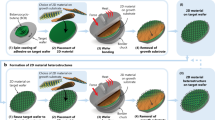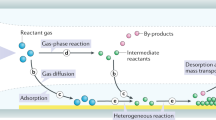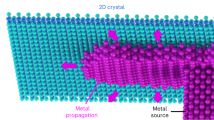Abstract
Chemical vapor deposition (CVD) has enabled two-dimensional (2D) materials and their heterostructures to become promising material platforms for next-generation electronics and photonic devices. However, the robust processing of 2D materials produced by CVD is currently hindered by the lack of a scalable and reliable technique to transfer materials from their growth substrates to target substrates for end applications. Here we introduced an automated system to enable the transfer of CVD-grown 2D materials with robotics by engineering the interfacial adhesion and strain. The developed automated transfer system shows industrial compatibility, as demonstrated by the high production capability (up to 180 wafers per day), reliable transfer quality (with transferred graphene carrier mobilities over 14,000 cm2 V−1 s−1), and high uniformity and repeatability of the transferred materials. The developed system also outperforms conventional manual transfer methods in terms of minimizing cost and environmental impact. This automated system could accelerate the research and commercialization of 2D materials in the future.

This is a preview of subscription content, access via your institution
Access options
Subscribe to this journal
Receive 12 digital issues and online access to articles
118,99 € per year
only 9,92 € per issue
Buy this article
- Purchase on SpringerLink
- Instant access to full article PDF
Prices may be subject to local taxes which are calculated during checkout





Similar content being viewed by others
Data availability
A more complete set of data including the code is accessible via figshare at https://doi.org/10.6084/m9.figshare.27896352 (ref. 65). Source data are provided with this paper.
Code availability
Code associated with the automated spin-coating machine and the automated lamination and delamination machine is available via figshare at https://doi.org/10.6084/m9.figshare.27896352 (ref. 65).
References
Sun, Z., Martinez, A. & Wang, F. Optical modulators with 2D layered materials. Nat. Photon. 10, 227–238 (2016).
Akinwande, D. et al. Graphene and two-dimensional materials for silicon technology. Nature 573, 507–518 (2019).
Gong, C. & Zhang, X. Two-dimensional magnetic crystals and emergent heterostructure devices. Science 363, eaav4450 (2019).
Kim, S. E. et al. Extremely anisotropic van der Waals thermal conductors. Nature 597, 660–665 (2021).
Dai, Z., Liu, L. & Zhang, Z. Strain engineering of 2D materials: issues and opportunities at the interface. Adv. Mater. 31, 1805417 (2019).
Montblanch, A. R.-P., Barbone, M., Aharonovich, I., Atatüre, M. & Ferrari, A. C. Layered materials as a platform for quantum technologies. Nat. Nanotechnol. 18, 555–571 (2023).
Novoselov, K., Mishchenko, A., Carvalho, A. & Castro Neto, A. 2D materials and van der Waals heterostructures. Science 353, aac9439 (2016).
Maleki, A. et al. Biomedical applications of MXene‐integrated composites: regenerative medicine, infection therapy, cancer treatment, and biosensing. Adv. Funct. Mater. 32, 2203430 (2022).
Lemme, M. C., Akinwande, D., Huyghebaert, C. & Stampfer, C. 2D materials for future heterogeneous electronics. Nat. Commun. 13, 1392 (2022).
Wang, W. et al. Clean assembly of van der Waals heterostructures using silicon nitride membranes. Nat. Electron. 6, 981–990 (2023).
Liu, L. et al. Ultrashort vertical-channel MoS2 transistor using a self-aligned contact. Nat. Commun. 15, 165 (2024).
Lin, L., Peng, H. & Liu, Z. Synthesis challenges for graphene industry. Nat. Mater. 18, 520–524 (2019).
Chen, T.-A. et al. Wafer-scale single-crystal hexagonal boron nitride monolayers on Cu (111). Nature 579, 219–223 (2020).
Ma, K. Y. et al. Epitaxial single-crystal hexagonal boron nitride multilayers on Ni (111). Nature 606, 88–93 (2022).
Li, L. et al. Epitaxy of wafer-scale single-crystal MoS2 monolayer via buffer layer control. Nat. Commun. 15, 1825 (2024).
Li, T. et al. Epitaxial growth of wafer-scale molybdenum disulfide semiconductor single crystals on sapphire. Nat. Nanotechnol. 16, 1201–1207 (2021).
Nakatani, M. et al. Ready-to-transfer two-dimensional materials using tunable adhesive force tapes. Nat. Electron. 7, 119–130 (2024).
Satterthwaite, P. F. et al. Van der Waals device integration beyond the limits of van der Waals forces using adhesive matrix transfer. Nat. Electron. 7, 17–28 (2024).
Yuan, G. et al. Stacking transfer of wafer-scale graphene-based van der Waals superlattices. Nat. Commun. 14, 5457 (2023).
Shin, J. et al. Vertical full-colour micro-LEDs via 2D materials-based layer transfer. Nature 614, 81–87 (2023).
Zhao, Y. et al. Large-area transfer of two-dimensional materials free of cracks, contamination and wrinkles via controllable conformal contact. Nat. Commun. 13, 4409 (2022).
Hu, Z. et al. Rapid and scalable transfer of large‐area graphene wafers. Adv. Mater. 35, 2300621 (2023).
Dai, Z. & Padture, N. P. Challenges and opportunities for the mechanical reliability of metal halide perovskites and photovoltaics. Nat. Energy 8, 1319–1327 (2023).
Jambhapuram, M., Good, J. K. & Azoug, A. Finite element investigation of lamination-induced curl due to residual stresses. Forces Mech. 4, 100034 (2021).
Kim, C. et al. Damage-free transfer mechanics of 2-dimensional materials: competition between adhesion instability and tensile strain. NPG Asia Mater. 13, 44 (2021).
Kim, J. et al. Layer-resolved graphene transfer via engineered strain layers. Science 342, 833–836 (2013).
Luo, D. et al. Role of graphene in water-assisted oxidation of copper in relation to dry transfer of graphene. Chem. Mater. 29, 4546–4556 (2017).
Gao, L. et al. Repeated growth and bubbling transfer of graphene with millimetre-size single-crystal grains using platinum. Nat. Commun. 3, 699 (2012).
Chen, S. et al. Oxidation resistance of graphene-coated Cu and Cu/Ni alloy. ACS Nano 5, 1321–1327 (2011).
Kashyap, P. K., Sharma, I. & Gupta, B. K. Continuous growth of highly reproducible single-layer graphene deposition on Cu foil by indigenously developed LPCVD setup. ACS Omega 4, 2893–2901 (2019).
Hong, N. et al. Roll-to-roll dry transfer of large-scale graphene. Adv. Mater. 34, 2106615 (2022).
Bae, S. et al. Roll-to-roll production of 30-inch graphene films for transparent electrodes. Nat. Nanotechnol. 5, 574–578 (2010).
Liu, L. et al. Uniform nucleation and epitaxy of bilayer molybdenum disulfide on sapphire. Nature 605, 69–75 (2022).
Wang, J. et al. Dual-coupling-guided epitaxial growth of wafer-scale single-crystal WS2 monolayer on vicinal a-plane sapphire. Nat. Nanotechnol. 17, 33–38 (2022).
Hong, J. Y. et al. A rational strategy for graphene transfer on substrates with rough features. Adv. Mater. 28, 2382–2392 (2016).
Park, H. et al. Analytic model of spalling technique for thickness-controlled separation of single-crystalline semiconductor layers. Solid State Electron. 163, 107660 (2020).
Kim, H. et al. Graphene nanopattern as a universal epitaxy platform for single-crystal membrane production and defect reduction. Nat. Nanotechnol. 17, 1054–1059 (2022).
Chen, L. et al. Fully automatic transfer and measurement system for structural superlubric materials. Nat. Commun. 14, 6323 (2023).
Automate and digitize. Nat. Synth. 2, 459 (2023).
Szymanski, N. J. et al. An autonomous laboratory for the accelerated synthesis of novel materials. Nature 624, 86–91 (2023).
Ryu, S. et al. Atmospheric oxygen binding and hole doping in deformed graphene on a SiO2 substrate. Nano Lett. 10, 4944–4951 (2010).
Petrone, N. et al. Chemical vapor deposition-derived graphene with electrical performance of exfoliated graphene. Nano Lett. 12, 2751–2756 (2012).
Ferrari, A. C. et al. Raman spectrum of graphene and graphene layers. Phys. Rev. Lett. 97, 187401 (2006).
Lee, J. E., Ahn, G., Shim, J., Lee, Y. S. & Ryu, S. Optical separation of mechanical strain from charge doping in graphene. Nat. Commun. 3, 1024 (2012).
Cao, Y. et al. Unconventional superconductivity in magic-angle graphene superlattices. Nature 556, 43–50 (2018).
Lu, X. et al. Superconductors, orbital magnets and correlated states in magic-angle bilayer graphene. Nature 574, 653–657 (2019).
Ago, H. et al. Controlled van der Waals epitaxy of monolayer MoS2 triangular domains on graphene. ACS Appl. Mater. Interfaces 7, 5265–5273 (2015).
Shi, Y. et al. van der Waals epitaxy of MoS2 layers using graphene as growth templates. Nano Lett. 12, 2784–2791 (2012).
Rao, R. et al. Spectroscopic evaluation of charge-transfer doping and strain in graphene/MoS2 heterostructures. Phys. Rev. B 99, 195401 (2019).
Shih, C.-J. et al. Tuning on–off current ratio and field-effect mobility in a MoS2–graphene heterostructure via Schottky barrier modulation. ACS Nano 8, 5790–5798 (2014).
Pescetelli, S. et al. Integration of two-dimensional materials-based perovskite solar panels into a stand-alone solar farm. Nat. Energy 7, 597–607 (2022).
Hauschild, M. Z. et al. Identifying best existing practice for characterization modeling in life cycle impact assessment. Int. J. Life Cycle Assess. 18, 683–697 (2013).
Bueno, C., Hauschild, M. Z., Rossignolo, J. A., Ometto, A. R. & Mendes, N. C. Sensitivity analysis of the use of Life Cycle Impact Assessment methods: a case study on building materials. J. Clean. Prod. 112, 2208–2220 (2016).
Yang, P. et al. Highly reproducible epitaxial growth of wafer-scale single-crystal monolayer MoS2 on sapphire. Small Methods 7, 2300165 (2023).
Kresse, G. & Furthmüller, J. Efficiency of ab-initio total energy calculations for metals and semiconductors using a plane-wave basis set. Comput. Mater. Sci. 6, 15–50 (1996).
Kresse, G. & Furthmüller, J. Efficient iterative schemes for ab initio total-energy calculations using a plane-wave basis set. Phys. Rev. B 54, 11169 (1996).
Kresse, G. & Joubert, D. From ultrasoft pseudopotentials to the projector augmented-wave method. Phys. Rev. B 59, 1758 (1999).
Perdew, J. P., Burke, K. & Ernzerhof, M. Generalized gradient approximation made simple. Phys. Rev. Lett. 77, 3865 (1996).
Lanthony, C. et al. On the early stage of aluminum oxidation: an extraction mechanism via oxygen cooperation. J. Chem. Phys. 137, 094707 (2012).
Park, Y. et al. Critical role of surface termination of sapphire substrates in crystallographic epitaxial growth of MoS2 using inorganic molecular precursors. ACS Nano 17, 1196–1205 (2023).
Yeh, L. et al. The dependence of the performance of strained NMOSFETs on channel width. IEEE Trans. Electron Devices 56, 2848–2852 (2009).
Monkhorst, H. J. & Pack, J. D. Special points for Brillouin-zone integrations. Phys. Rev. B 13, 5188 (1976).
Wang, V., Xu, N., Liu, J.-C., Tang, G. & Geng, W.-T. VASPKIT: a user-friendly interface facilitating high-throughput computing and analysis using VASP code. Comput. Phys. Commun. 267, 108033 (2021).
Berland, K. & Hyldgaard, P. Exchange functional that tests the robustness of the plasmon description of the van der Waals density functional. Phys. Rev. B 89, 035412 (2014).
Zhao, Y. et al. Automated processing and transfer of two-dimensional materials with robotics. figshare https://doi.org/10.6084/m9.figshare.27896352 (2025).
Acknowledgements
This work was financially supported by the National Natural Science Foundation of China (nos T2188101 and 52372038) and the National Key Research and Development Program of China (nos 2024YFE0202200, 2022YFA1204900 and 2023YFB3609900), Science and Technology Development Fund, Macau SAR (0107/2024/AMJ). We acknowledge the Molecular Materials and Nanofabrication Laboratory (MMNL) in the College of Chemistry and Peking Nanofab, Peking University, for the use of instruments, and thank the Materials Processing and Analysis Center, Peking University, for assistance with Raman characterization.
Author information
Authors and Affiliations
Contributions
L.L. and Z.L. conceived the experiment. L.L., Z.L. and B.M. supervised the project. Y. Zhao, J.L., Z.H., Q.Z., G.C., Q.L., M.S. and B.G. conducted the transfer of 2D materials onto the target substrates. Y. Zhao, Z.H., Q.Z. and Q.X. took and analyzed the OM, X-ray photoelectron spectroscopy, scanning electron microscopy and AFM data. J.L. and Y. Zhao conducted the Raman and PL measurements on the transferred 2D materials. Y. Zhao and J.L. performed the device fabrication and electrical measurements. Y. Zhao and G.W. conducted the film stress measurement. S.B. conducted the calculation of adhesion energies. Y. Zhao and Z.H. conducted the transmission electron microscopy characterization and analysis. K.J. conducted the CVD growth of graphene. J.H. and Y. Zhang conducted the growth of MoS2. Y. Zhao, B.M., E.E. and M.G. conducted the LCA and technoeconomic analyses. All authors discussed the results and wrote the paper.
Corresponding authors
Ethics declarations
Competing interests
The authors declare no competing interests.
Peer review
Peer review information
Nature Chemical Engineering thanks Timothy J. Booth, Kuangye Lu and the other, anonymous, reviewer(s) for their contribution to the peer review of this work
Additional information
Publisher’s note Springer Nature remains neutral with regard to jurisdictional claims in published maps and institutional affiliations.
Supplementary information
Supplementary Information
Supplementary Figs. 1–23 and Tables 1–12.
Supplementary Video 1
Manual-bubbling-based wet transfer process works with the assistance of PMMA.
Supplementary Video 2
Manual transfer including the polycarbonate-assisted exfoliation of graphene from a growth substrate and the removal of polycarbonate by chloroform.
Supplementary Video 3
Automated spin-coating process based on the automated spin coater built in-house.
Supplementary Video 4
Lamination and delamination processes based on the automated laminating and delaminating machine built in-house.
Supplementary Video 5
Lamination and delamination processes based on the automated laminating and delaminating machine for the transfer of a 4-inch MoS2.
Source data
Source Data Fig. 2
Statistical source data.
Source Data Fig. 4
Statistical source data.
Source Data Fig. 5
Statistical source data.
Rights and permissions
Springer Nature or its licensor (e.g. a society or other partner) holds exclusive rights to this article under a publishing agreement with the author(s) or other rightsholder(s); author self-archiving of the accepted manuscript version of this article is solely governed by the terms of such publishing agreement and applicable law.
About this article
Cite this article
Zhao, Y., Liao, J., Bu, S. et al. Automated processing and transfer of two-dimensional materials with robotics. Nat Chem Eng 2, 296–308 (2025). https://doi.org/10.1038/s44286-025-00227-5
Received:
Accepted:
Published:
Issue Date:
DOI: https://doi.org/10.1038/s44286-025-00227-5



